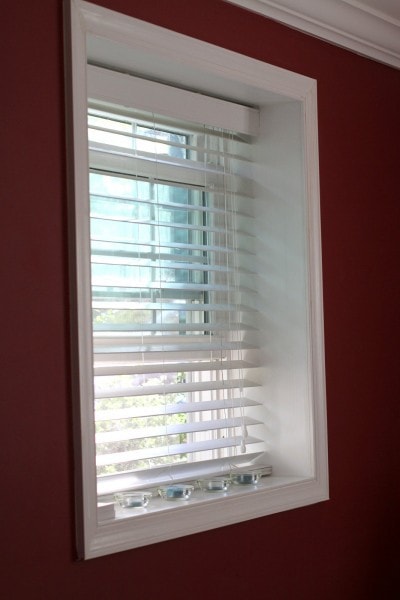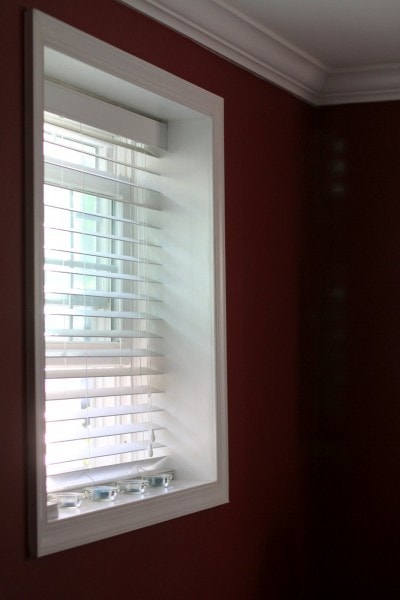Since it’s Memorial Day, I wasn’t going to post today, but I need some help from you guys!
Mr. FG works some odd hours no matter what shift he’s on, which means that we are frequently getting at least part of our sleep when the sun is up (especially during the longer days of summer).
So, we’ve been wanting to buy some blackout window coverings for our bedroom.
I’m having a dreadful time figuring out what to get though, and I was hoping maybe some of you would have recommendations for us.
Here’s a poorly-taken quick snapshot of the type of windows we have:

We have three of these to outfit.
I’ve looked at covers that you velcro up, and while these are inexpensive and seem to work like a charm, I don’t like the idea of having to take them down every day (I really don’t want to leave my bedroom pitch black all day long.)
I looked at Roman shades, but I read conflicting reports about how well they block light. The blackout versions tend to be quite expensive, and I’d hate to pay a bunch of money for something that doesn’t work much better than our current blinds.
I’ve also thought about blackout curtains, but I’m having trouble finding some with a light-colored front panel. Our room has burgundy walls and is on the north side of the house, so if I put dark curtains up, I’m afraid it will feel very, very dark.
I did find a few white versions, but reviewers complained about the shower-curtain-ish feel of them.
Another option is to buy regular curtains and sew a blackout lining (using fabric like this) onto them.

Oof.
I’m having major decision fatigue, so I would dearly love some advice from you. Help me figure out something that’s not crazy expensive, ugly, or inconvenient. 😉
(If that’s even possible!)

Amy Winters
Wednesday 22nd of May 2019
As I was reading your article about blackout window treatment suggestions, you talk about having issues finding blackout curtains that would match your burgundy walls. I assume that you have thought about window blind coverings. My husband and I had a hard time finding the right kind of blackout curtains for our babies room.
Rachel Anderson
Wednesday 12th of October 2016
Hi Kristen,
I see that this post was written over 2 years ago, so you've probably found a solution by now, but I wanted to share a tutorial that I wrote on making your own DIY No-Sew Removable Blackout Curtain Liners. I had a set of curtains that I wanted to turn into blackout curtains without permanently attaching the liner to the curtain. I bought some blackout liner fabric and made some liners that look seamless, but are completely detachable. And it cost less than $20 per panel! You can check out the full tutorial here: https://seagraindesign.wordpress.com/2016/09/14/diy-no-sew-blackout-curtain-liners/
Cheers! Rachel
Krysten
Saturday 31st of May 2014
My son is super sensetive to light so in the hopes of more sleep for us all I kept his light colored curtains and added those clip-on curtain rings. Because I could attach a piece of blackout fabric to the back, but didn't have to sew it on, the curtains are easy to take down/wash etc. we haven't had any trouble with the being light colored/letting in too much light.
Heather
Friday 30th of May 2014
We had a similar situation because we live in Denver and it gets light here super early in the morning! I was super reluctant to try out "faux silk" curtains from Wal-Mart, but I couldn't be happier with them. They could easily be fancied up with some trim sew along the edges. They come in a few light colors. http://www.walmart.com/ip/Better-Homes-and-Gardens-Back-Tab-Window-Panel/20927048
They are $21 per panel which is a really fair price!
Good luck!
EngineerMom
Friday 30th of May 2014
We live far enough north that blackout curtains are required in the summer for the kids to get any sleep!
I ended up making a curtain for their one big window - fabric from JoAnn, sewed with a simple sleeve at the top for a rod, and with blackout fabric (bought with a coupon) sewed along the seam of the pocket to hang loose behind the curtain. You really don't need to attach it everywhere - just a single seam across the top is enough, and helps to avoid weird sags or bulges if you didn't get all the edge seams perfectly aligned.